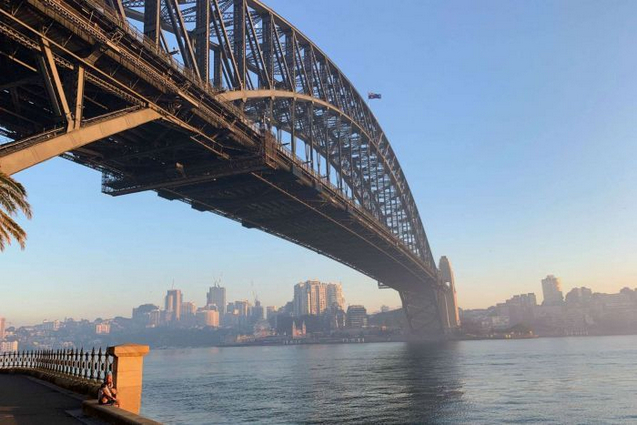Sydney was wreathed in bushfire smoke. (ABC News)
Key Points
|
At least 60 people were treated by paramedics for health complications caused by the smoke haze, according to NSW Ambulance.
Superintendent Jordan Emery said some calls for help were severe and required transport to hospital.
"Western Sydney has been particularly heavily affected as a result of the proximity to the bushfire burning just north of Sydney," he said.
Superintendent Emery said that although older people were more vulnerable to respiratory problems, younger people with asthma also required assistance today.
Authorities said while conditions had improved in Sydney's west, further east and around the CBD the air had not completely cleared.
The haze came amid total fire bans in many parts of the state, and forecasts of a heatwave later this week, with temperatures expected to climb past 40 degrees Celsius in some areas.
 |
| Sydney CBD blanketed with a smoke haze on Tuesday. (AAP: Joel Carrett) |
NSW Health's Director of Environmental Health Doctor Richard Broome said the bad air quality and hot temperatures posed a serious risk.
"If you are somewhere where it's smoky it continues to be really important to avoid outdoor physical activity if you can.
"Especially if you're someone who has a chronic respiratory or heart condition and are more sensitive to smoke."
The smoke spread from the Gospers Mountain fire, which has burnt more than 120,000 hectares north-west of Sydney and remains out of control.
Hot and dry conditions also created challenging conditions for firefighters at Ebor, between Armidale and Coffs Harbour.
There are dozens of fires burning across the state and today's conditions had the Rural Fire Service (RFS) on high alert.
There are 1,400 firefighters working to curb the spread of those fires, but RFS Commissioner Shane Fitzsimmons said there was "the potential for real challenges".
 |
| Smoke haze blanketing the Parramatta River near Rhodes. (AAP: Danny Casey) |
A northerly wind will make its way down the coast and inland, before swinging around to the south-west and strengthening, and later a blustery southerly will travel up the coast.
How to cope with the smoke  |
|
|
The air quality was worst in western Sydney, around Richmond and Rouse Hill, where air pollution is around two to three times the national standard.
Dr Broome said the risks from the smoke were minor for most people, with sore eyes and a sore throat the most common symptoms.
However, people who have pre-existing conditions like asthma or emphysema may be at slightly higher risk of developing problems.
"[For those people] it's actually better to stay indoors, keeping your windows and doors shut," he said.
But with no end in sight for the fires, which kicked off earlier than normal this year, Dr Broome advised people to adapt.
"People just need to build it into their routine a little bit for the next period of time," he said.
Dr Broome also said it could be smoky again tomorrow, with that pattern continuing until the end of the week.
"It's also going to be very hot, especially in Western Sydney and further north in New South Wales. We're expecting heatwave conditions, mostly from Wednesday onwards," he said.
 |
| The smoke came from a bushfire in Gospers Mountain, north-west of Sydney. (ABC News: Antonette Collins) |
"My eyes are stinging, my daughter's coughing her guts out," said one woman at Milsons Point.
Another said: "It's disgusting. I was woken up about two o'clock this morning and it was terrible."
"I'm finding it difficult to breathe and I don't have any health issues."
 |
| Some people exercising outdoors were unfazed by the health warnings. (ABC News: Antonette Collins) |
Links
- Get the latest RFS advice here
- Scientists say the NSW mega fires are linked to climate change. Here's how
- Doctors 'Obliged To Speak On Climate Risk' As Smoke Blankets Sydney
- It's hard to breathe': Bushfires cause choking air pollution in south-east Queensland
- Nearly 500 NSW homes lost to bushfires as crews scramble to build containment lines
- Smoke chokes Sydney as more than 50 people treated for breathing-related incidents
- Air quality and pollution city ranking
- Sydney's bushfire smoke haze leaves 60 people needing treatment from paramedics







